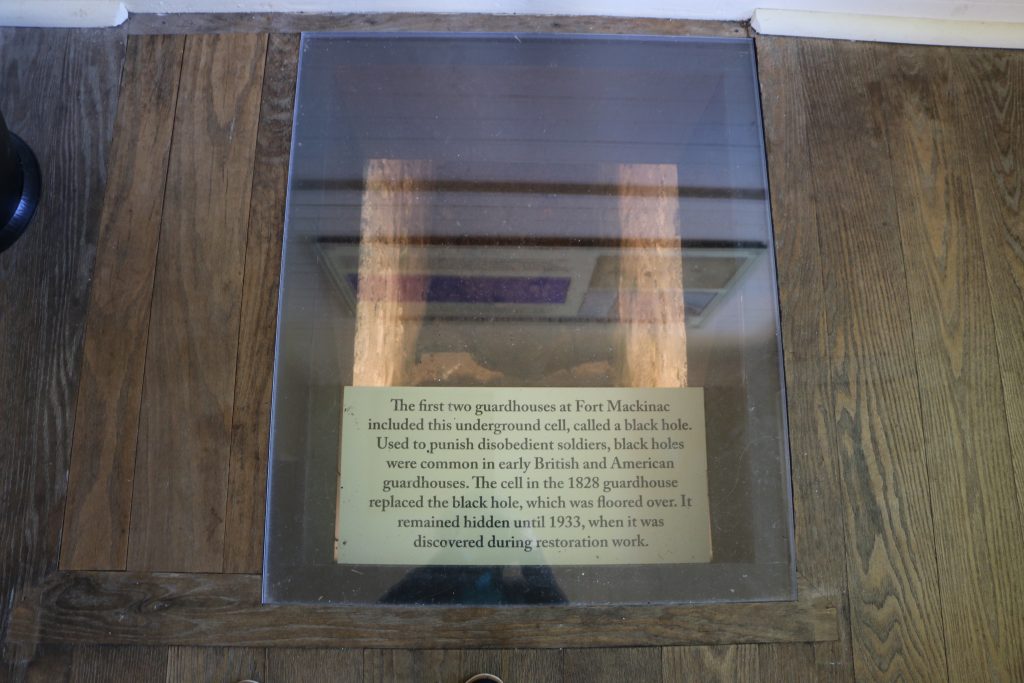Albert Einstein conceived of the possibility more than a century ago and astronomers now have photographed one for the first time. Yet, it was physicist John Wheeler who coined the term “black hole.” What a great way to describe a part of outer space so dense that nothing – not even light – can escape from it.
It’s almost as if Wheeler was inspired by a trip to Fort Mackinac!
After all, the fort’s guardhouse featured an earthen “black hole” long before Einstein’s theory of general relativity hypothesized the existence of a cosmic version. The black hole that served as a crude prison cell on Mackinac Island in the late 18th and early 19th centuries remains a popular spot for tourists to gawk during a visit to the historic fort on the Mackinac Island bluff.
Fort Mackinac’s Black Hole
Fort Mackinac’s “Black Hole” was exactly that – a hole in the ground with stone walls, a dirt floor and very little light or fresh air. It was used to discipline troops who stepped out of line: “The damp suffocating darkness of this underground cell was designed to break the spirit of even the most rebellious soldiers,” states a plaque in the fort’s restored guardhouse.
The use of a “black hole” for the incarceration of military prisoners is documented as far back as the mid-1700s when what was then known as Fort Michilimackinac existed on the mainland, said Phil Porter, director of Mackinac State Historic Parks.
Using a black hole for a jail continued after Fort Michilimackinac was moved from what is now Mackinaw City across the water to Mackinac Island in 1780. The existing black hole that you can still see today was used until 1828, when the current guardhouse was built to replace an earlier structure that had deteriorated.
A look at Mackinac Island history through the centuries
Behaviors That Got Fort Mackinac Soldiers Thrown In The Black Hole
It apparently was fairly common for fort authorities to put soldiers in the black hole, even for seemingly insignificant offenses. Porter cites an 1834 incarceration of Private James Evans, who stated during a general court martial that “every time I got a little liquor in me, I have been shoved in the blackhole and kept eight or 10 days on bread and water at a time.”
In the so-called Christmas Mutiny of 1829, several drunken soldiers attacked their superior, Lt. Ephraim Kirby Smith, who was planning to whip a fellow soldier for bringing alcohol into the fort. The uprising fizzled and seven soldiers were convicted in the assault. In addition to six months of hard labor and the loss of both pay and whisky ration for six months, the sentence for at least one of the soldiers included confinement in the black hole when not on duty.
“We do not have any documentation on the protocol of how and when the black hole was used,” Porter said. “I suspect that there was no set practice and that it depended, in many cases, on the whim of the commandant or officer of the day.”
The plaque at the fort states that one unfortunate soldier died while serving time in the hole in the spring of 1800. There’s also some evidence that at one time “an Indian was placed in the ‘Black Hole’ and later taken out dead.”
The black hole at Fort Mackinac eventually was abandoned and covered with new flooring. The hole was rediscovered in the 1930s by workmen repairing that floor. The black hole remains intact as part of the restored guardhouse and you can peer into it during a tour of Fort Mackinac still today!
RELATED MACKINAC ISLAND BLOGS:





